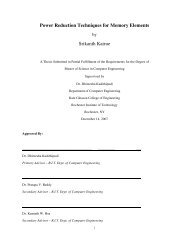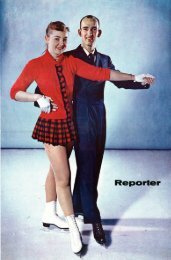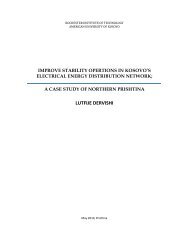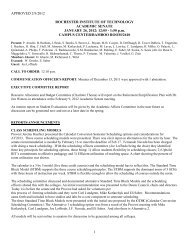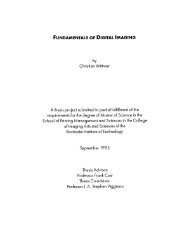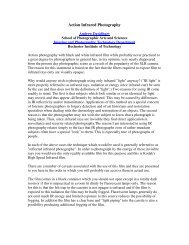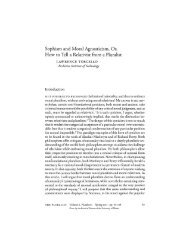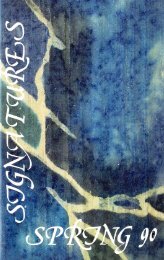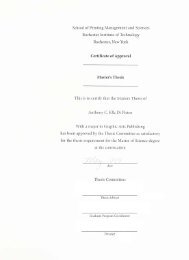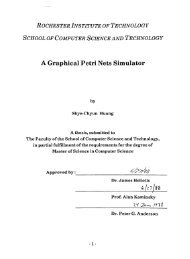Self-Portrait as the Allegory of Painting (La Pittura) Maureen Lester ...
Self-Portrait as the Allegory of Painting (La Pittura) Maureen Lester ...
Self-Portrait as the Allegory of Painting (La Pittura) Maureen Lester ...
You also want an ePaper? Increase the reach of your titles
YUMPU automatically turns print PDFs into web optimized ePapers that Google loves.
Practice, or <strong>the</strong> relationship between <strong>the</strong> material concerns <strong>of</strong> painting with its higher <strong>as</strong>pects <strong>of</strong><br />
intellect (Garrard 108). With one aim raised upward, <strong>the</strong> hand stretching toward an invisible<br />
target, she suggests <strong>the</strong> painting's higher ide<strong>as</strong>, while <strong>the</strong> o<strong>the</strong>r arm firmly resting on <strong>the</strong> table<br />
holding <strong>the</strong> tools <strong>of</strong> painting conjures up <strong>the</strong> notion <strong>of</strong> material concerns (109). In <strong>La</strong> <strong>Pittura</strong>,<br />
however, instead <strong>of</strong> separating <strong>the</strong> two <strong>as</strong> w<strong>as</strong> common, Artemisia unites <strong>the</strong>m in a continuous<br />
arc in <strong>the</strong> composition (109). The head serves <strong>as</strong> <strong>the</strong> center <strong>of</strong> <strong>the</strong> arc, speaking to <strong>the</strong> fact that<br />
<strong>the</strong> two diverse ide<strong>as</strong> are joined in <strong>the</strong> mind <strong>of</strong> <strong>the</strong> artist, and provides a point <strong>of</strong> resolution for<br />
<strong>the</strong> two <strong>as</strong>pects (109). That she chose to suggest this abstract allegory through a realistic human<br />
form suggests that Artemisia believed that painting's worth <strong>as</strong> art derives from <strong>the</strong> work <strong>of</strong> <strong>the</strong><br />
artist ra<strong>the</strong>r that <strong>as</strong>sociation with royalty or <strong>the</strong>oretical pretension (109).<br />
Artemisia takes some creative license in her painting <strong>as</strong> well. According to Ripa, <strong>Pittura</strong><br />
w<strong>as</strong> supposed to wear a long dress covering her feet, creating a metaphor between <strong>the</strong> covered<br />
female body and <strong>the</strong> ideal proportions <strong>of</strong> painting, established in <strong>the</strong> underdrawing but disguised<br />
in <strong>the</strong> final work when <strong>the</strong> color is added (Garrard 107). Artemisia ignores this focus, and<br />
instead leaves out <strong>the</strong> skirt and feet altoge<strong>the</strong>r, placing <strong>the</strong> figure in a foreshortened, transitory,<br />
active pose (107). In doing so, she prevents <strong>the</strong> viewer from discovering <strong>the</strong> conventional<br />
symmetry, beauty, and proportion, <strong>as</strong> well <strong>as</strong> <strong>the</strong> arched eyebrows, that Ripa had specified (107).<br />
It is important to note that <strong>the</strong> canv<strong>as</strong> w<strong>as</strong> cleaned in 1972, which removed later<br />
repainting on <strong>the</strong> background (Bissell 272). Certain are<strong>as</strong> were painted ra<strong>the</strong>r thinly on <strong>the</strong> finely<br />
woven canv<strong>as</strong>, which, coupled with loss <strong>of</strong> glazes, have resulted in <strong>the</strong> dark preparatory ground<br />
to be visible in some places (272). This renders <strong>the</strong> impression <strong>the</strong> picture w<strong>as</strong> unfinished, but<br />
that is not <strong>the</strong> c<strong>as</strong>e (272).<br />
373



